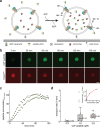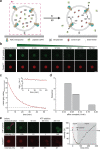Single Cell-like Systems Reveal Active Unidirectional and Light-Controlled Transport by Nanomachineries
- PMID: 33724767
- PMCID: PMC8157534
- DOI: 10.1021/acsnano.0c10139
Single Cell-like Systems Reveal Active Unidirectional and Light-Controlled Transport by Nanomachineries
Abstract
Cellular life depends on transport and communication across membranes, which is emphasized by the fact that membrane proteins are prime drug targets. The cell-like environment of membrane proteins has gained increasing attention based on its important role in function and regulation. As a versatile scaffold for bottom-up synthetic biology and nanoscience, giant liposomes represent minimalistic models of living cells. Nevertheless, the incorporation of fragile multiprotein membrane complexes still remains a major challenge. Here, we report on an approach for the functional reconstitution of membrane assemblies exemplified by human and bacterial ATP-binding cassette (ABC) transporters. We reveal that these nanomachineries transport substrates unidirectionally against a steep concentration gradient. Active substrate transport can be spatiotemporally resolved in single cell-like compartments by light, enabling real-time tracking of substrate export and import in individual liposomes. This approach will help to construct delicate artificial cell-like systems.
Keywords: ABC transporter; giant liposomes; membrane transport; single-liposome analysis; synthetic biology.
Conflict of interest statement
The authors declare no competing financial interest.
Figures




Similar articles
-
ABC Transporters in Bacterial Nanomachineries.Int J Mol Sci. 2023 Mar 25;24(7):6227. doi: 10.3390/ijms24076227. Int J Mol Sci. 2023. PMID: 37047196 Free PMC article. Review.
-
A single power stroke by ATP binding drives substrate translocation in a heterodimeric ABC transporter.Elife. 2020 Apr 21;9:e55943. doi: 10.7554/eLife.55943. Elife. 2020. PMID: 32314962 Free PMC article.
-
Reconstitution of ATP-dependent lipid transporters: gaining insight into molecular characteristics, regulation, and mechanisms.Biosci Rep. 2023 Aug 31;43(8):BSR20221268. doi: 10.1042/BSR20221268. Biosci Rep. 2023. PMID: 37417269 Free PMC article. Review.
-
Combining Mutations That Inhibit Two Distinct Steps of the ATP Hydrolysis Cycle Restores Wild-Type Function in the Lipopolysaccharide Transporter and Shows that ATP Binding Triggers Transport.mBio. 2019 Aug 20;10(4):e01931-19. doi: 10.1128/mBio.01931-19. mBio. 2019. PMID: 31431556 Free PMC article.
-
A solute-binding protein in the closed conformation induces ATP hydrolysis in a bacterial ATP-binding cassette transporter involved in the import of alginate.J Biol Chem. 2017 Sep 22;292(38):15681-15690. doi: 10.1074/jbc.M117.793992. Epub 2017 Aug 2. J Biol Chem. 2017. PMID: 28768763 Free PMC article.
Cited by
-
Function Investigations and Applications of Membrane Proteins on Artificial Lipid Membranes.Int J Mol Sci. 2023 Apr 13;24(8):7231. doi: 10.3390/ijms24087231. Int J Mol Sci. 2023. PMID: 37108393 Free PMC article. Review.
-
Experimental platform for the functional investigation of membrane proteins in giant unilamellar vesicles.Soft Matter. 2022 Aug 10;18(31):5877-5893. doi: 10.1039/d2sm00551d. Soft Matter. 2022. PMID: 35916307 Free PMC article.
-
De novo macrocyclic peptides dissect energy coupling of a heterodimeric ABC transporter by multimode allosteric inhibition.Elife. 2021 Apr 30;10:e67732. doi: 10.7554/eLife.67732. Elife. 2021. PMID: 33929325 Free PMC article.
-
Light-Triggered Protease-Mediated Release of Actin-Bound Cargo from Synthetic Cells.Adv Biol (Weinh). 2025 May;9(5):e2400539. doi: 10.1002/adbi.202400539. Epub 2025 Jan 18. Adv Biol (Weinh). 2025. PMID: 39825686 Free PMC article.
References
Publication types
MeSH terms
Substances
LinkOut - more resources
Full Text Sources
Other Literature Sources
Research Materials

